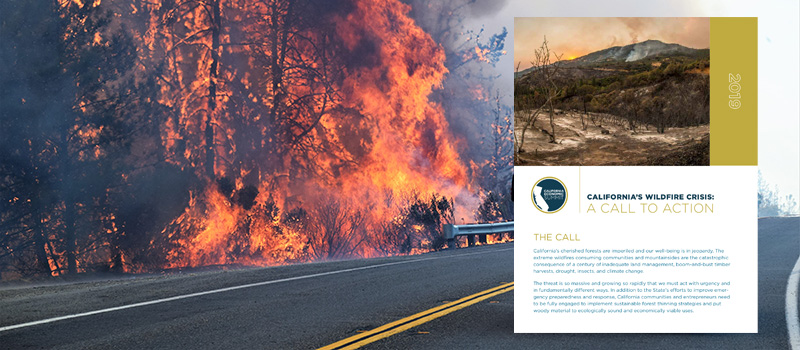
(Photo: Eric Coulter/BLM)
The wildfire crisis gripping California has touched every corner of the state. Beyond the loss of lives and destruction in communities, a grim cascade of harms has unfolded for people living in both rural and urban communities: Smoke-filled air many miles from fires. Threatened water supplies. Ever increasing firefighting and recovery costs. Skyrocketing insurance bills. Power shutoffs with widespread economic consequences.
In a new report, “California’s Wildfire Crisis: A Call to Action,” CA Fwd and the California Economic Summit have captured the terrible toll of the crisis and the need for solutions that mirror the size and scale of the problem. As the Call to Action explains, it will take a collective “moonshot” in which all Californians – from government and business leaders to educators and individuals – grow in their understanding of the problem and contribute to solutions.
The Call to Action will be reviewed and discussed during the upcoming 2019 California Economic Summit in Fresno November 7 and 8, where participants also will also explore action steps that the Summit’s partners can support to achieve a more wildfire-safe state. The report grew out of the Summit’s ongoing Elevate Rural CA initiative, which, in addition to forest resiliency, seeks to expand broadband access and address water infrastructure needs in rural communities.
While wildfires are occurring across many diverse landscapes, the Call to Action highlights a key means of reducing these catastrophic events: Ramping up work to thin and manage at least one million acres of forested land annually over the next decade in ways that enhance forest resiliency and a climate-resilient landscape. This is a critical goal articulated in the California Forest Carbon Plan and supported by numerous scientists, forestry practitioners, government leaders and policy experts.
The Call to Action explains that the efforts should include development of new wood product industries that can make productive use of extracted woody materials, help pay for forestry treatments, and help create jobs and revitalize rural economies. Importantly, this forest treatment work is just the first step in what must be a much larger effort to effectively manage our forests, ecosystems and landscapes amid a changing climate.
Wildfire dangers are growing because of increasingly overgrown conditions in forests and wildlands and more people living near them. Today, 4.5 million homes and 11 million people live and work in the wildland-urban interface.
The 2017 and 2018 wildfire seasons were the most destructive in state history, with more than 9,000 wildfires igniting in 2017 and nearly 7,600 the next year. Together, they burned 2.8 million acres, destroyed tens of thousands of homes, and killed 139 people. During 2018, the worst fire year on record, 19,000 homes and other structures were damaged or destroyed in one fire alone: The Camp Fire in Butte County, where the town of Paradise was nearly obliterated and 86 people – many frail and elderly – perished.
The Call to Action notes that the state’s response to the wildfire crisis has been significant, including expanding firefighting and emergency resources, helping communities recover, and increasing forest resilience work. Based on input from Summit partners and stakeholders, the Call to Action highlights principles that will be critical for solving the crisis, including scaling up ecologically sound solutions at the landscape and watershed scale, growing private capital and enterprise, supporting partnerships across governments and sectors, and leadership by the State.
The report builds on several years of significant research and work by many other organizations and entities, a number of which are highlighted in throughout the report and in its Appendix. They include state and local governments, academic institutions and think tanks, the Little Hoover Commission, The Nature Conservancy, the Legislative Analyst’s Office, the Forest Management Task Force, and a several local collaboratives.

